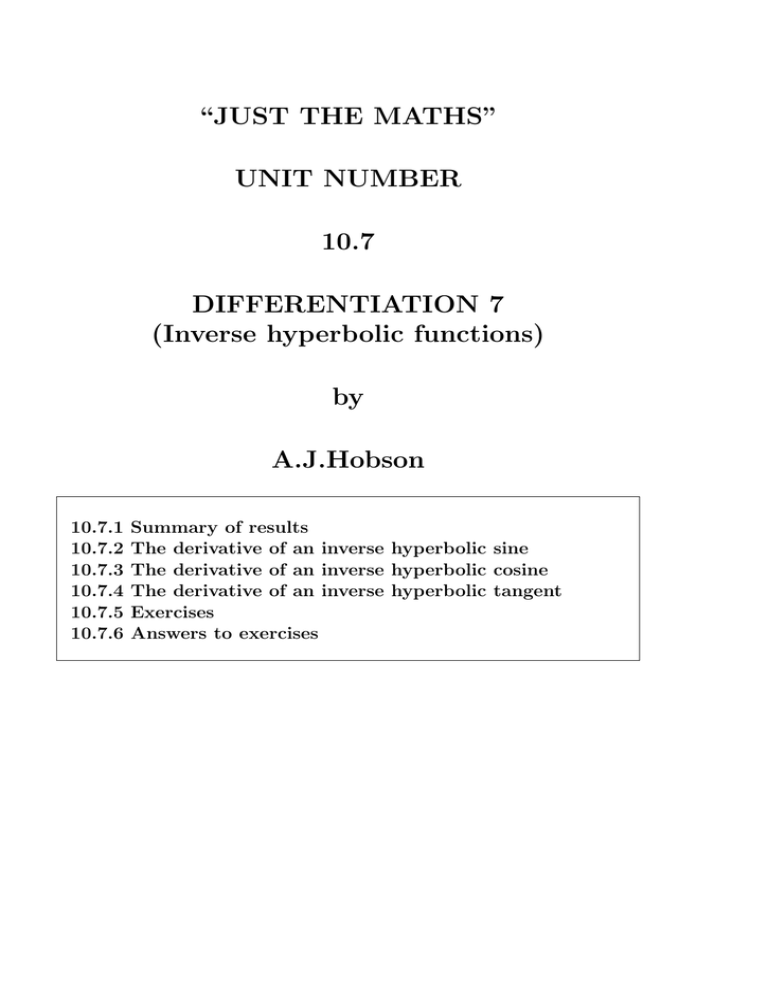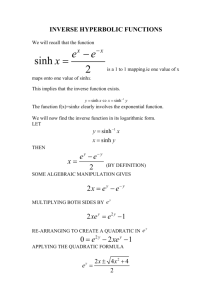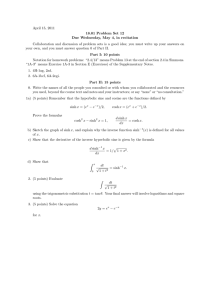“JUST THE MATHS” UNIT NUMBER 10.7 DIFFERENTIATION 7
advertisement

“JUST THE MATHS” UNIT NUMBER 10.7 DIFFERENTIATION 7 (Inverse hyperbolic functions) by A.J.Hobson 10.7.1 10.7.2 10.7.3 10.7.4 10.7.5 10.7.6 Summary of results The derivative of an inverse hyperbolic sine The derivative of an inverse hyperbolic cosine The derivative of an inverse hyperbolic tangent Exercises Answers to exercises UNIT 10.7 - DIFFERENTIATION DERIVATIVES OF INVERSE HYPERBOLIC FUNCTIONS 10.7.1 SUMMARY OF RESULTS The derivatives of inverse trigonometric and inverse hyperbolic functions should be considered as standard results. They will be stated here, first, before their proofs are discussed. 1. d 1 [sinh−1 x] = √ , dx 1 + x2 where −∞ < sinh−1 x < ∞. 2. d 1 [cosh−1 x] = √ 2 , dx x −1 where cosh−1 x ≥ 0. 3. d 1 [tanh−1 x] = , dx 1 − x2 where −∞ < tanh−1 x < ∞. 10.7.2 THE DERIVATIVE OF AN INVERSE HYPERBOLIC SINE We shall consider the formula y = Sinh−1 x and determine an expression for dy . dx Note: The use of the upper-case S in the formula is temporary; and the reason will be explained shortly. The formula is equivalent to x = sinh y, so we may say that q √ dx = cosh y ≡ 1 + sin2 y ≡ 1 + x2 , dy 1 noting that cosh y is never negative. Thus, dy 1 . =√ dx 1 + x2 Consider now the graph of the formula y = Sinh−1 x which may be obtained from the graph of y = sinh x by reversing the roles of x and y and rearranging the new axes into the usual positions. We obtain: y 6 -x O Observations (i) The variable x may lie anywhere in the interval −∞ < x < ∞. (ii) For each value of x, the variable y has only one value. (iii) For each value of x, there is only one possible value of dy , dx which is positive. (iv) In this case (unlike the case of an inverse sine, in Unit 10.6) there is no need to distinguish between a general value and a principal value of the inverse hyperbolic sine function. This is because there is only one value of both the function and its derivative. However, it is customary to denote the inverse function by sinh−1 x, using a lower-case s rather than an upper-case S. Hence, d 1 [sinh−1 x] = √ . dx 1 + x2 2 10.7.3 THE DERIVATIVE OF AN INVERSE HYPERBOLIC COSINE We shall consider the formula y = Cosh−1 x and determine an expression for dy . dx Note: There is a special significance in using the upper-case C in the formula; the reason will be explained shortly. The formula is equivalent to x = cosh y, so we may say that q √ dx = sinh y ≡ ± cosh2 y − 1 ≡ ± x2 − 1. dy Thus, dy 1 =√ 2 . dx x −1 Consider now the graph of the formula y = Cosh−1 x, which may be obtained from the graph of y = cosh x by reversing the roles of x and y and rearranging the new axes into the usual positions. We obtain: y 6 O -x 1 3 Observations (i) The variable x must lie in the interval x ≥ 1. (ii) For each value of x in the interval x > 1, the variable y has two values one of which is positive and the other negative. (iii) For each value of x in the interval x > 1, there are only two possible values of of which is postive and the other negative. dy , dx one (iv) By restricting the discussion to the part of the graph for which y ≥ 0, there will be only dy one value of y with one (positive) value of dx for each value of x in the interval x ≥ 1. The restricted part of the graph defines what is called the “principal value” of the inverse cosine function and is denoted by cosh−1 x, using a lower-case c. Hence, d 1 . [cosh−1 x] = √ 2 dx x −1 10.7.4 THE DERIVATIVE OF AN INVERSE HYPERBOLIC TANGENT We shall consider the formula y = Tanh−1 x and determine an expression for dy . dx Note: The use of the upper-case T in the formula is temporary; and the reason will be explained later. The formula is equivalent to x = tanh y, so we may say that dx = sech2 y ≡ 1 − tanh2 y ≡ 1 − x2 . dy Thus, dy 1 = . dx 1 − x2 Consider now the graph of the formula y = Tanh−1 x, 4 which may be obtained from the graph of y = tanh x by reversing the roles of x and y and rearranging the new axes into the usual positions. We obtain: y 6 −1 O 1 -x Observations (i) The variable x must lie in the interval −1 < x < 1. (ii) For each value of x in the interval −1 < x < 1, the variable y has just one value. (iii) For each value of x in the interval −1 < x < 1, there is only possible value of is positive. dy , dx which (iv) In this case (unlike the case of an inverse tangent in Unit 10.6) there is no need to distinguish between a general value and a principal value of the inverse hyperbolic tangent function. This is because there is only one value of both the function and its derivative. However, it is customary to denote the inverse hyperbolic tangent by tan−1 x using a lowercase t rather than an upper-case T. Hence, d 1 [tanh−1 x] = . dx 1 − x2 ILLUSTRATIONS 1. d sech2 x [sin−1 (tanh x)] = q = sechx. dx 1 − tanh2 x 5 2. d 5 [cosh−1 (5x − 4)] = q , dx (5x − 4)2 − 1 assuming that 5x − 4 ≥ 1; that is, x ≥ 1. 10.7.5 EXERCISES Obtain an expression for dy dx in the following cases: 1. y = cosh−1 (4 + 3x), assuming that 4 + 3x ≥ 1; that is, x ≥ −1. 2. y = cos−1 (sinh x), assuming that −1 ≤ sinh x ≤ 1. 3. y = tanh−1 (cos x). 4. y = cosh−1 (x3 ), assuming that x ≥ 1. 5. y = tanh−1 6 2x . 1 + x2 10.7.6 ANSWERS TO EXERCISES 1. 3 q (4 + 3x)2 − 1 . 2. cosh x −q 1 − sinh2 x 3. −cosecx. 4. √ 3x2 . x6 − 1 5. 2 . 1 − x2 7 .




